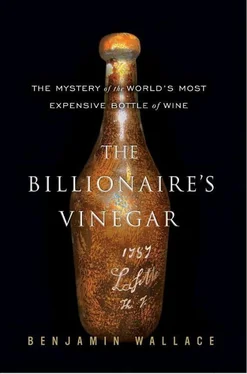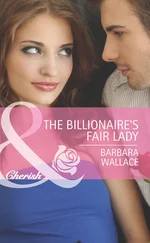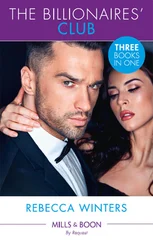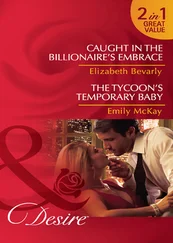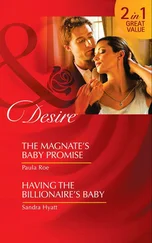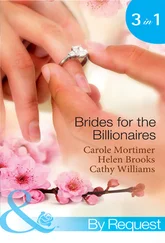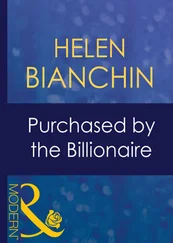Reaction to the GSF results in the wine world came quickly. James Laube, a columnist for Wine Spectator, publicly called on Rodenstock to come clean about the provenance of the Jefferson bottles. And the repercussions were felt beyond the tiny club of rich men who owned the bottles. Auctioneers and merchants from Germany to Switzerland to the UK reported severe disruptions in the old-wine market. “There is almost no interest in nineteenth- or eighteenth-century wines anymore,” Stephen Browett, whose Farr Vintners had sold more Jefferson bottles than anyone else, told Wine Spectator in early 1993. “Since the story broke in the press last June, collectors have treated pre-1900 bottles with skepticism.”
Even Broadbent seemed fed up with it all. “I just wish Hardy Rodenstock would say how he came by these bottles,” he told a newspaper. “It’s doing a tremendous amount of damage to the old fine and rare market.”
CHAPTER 14

LETTERS FROM HUBSI
DARKLY SUGGESTING THAT THE FIX WAS IN, RODENSTOCK claimed that the Frericks bottle had been doctored in order to hurt his wine business. He also issued a statement in which he asserted that “the renowned Jefferson Institute [i.e., Monticello] has found enough evidence… to prove that Jefferson indeed ordered the wines.” Alleging that it was the “assumption of many wine experts” that Frericks had replaced the original wine in the bottle with new wine and changed the seal, Rodenstock filed a complaint with the Munich state prosecutor charging Frericks with “making a false public oath.” Under German law, the prosecutor was required to take the complaint at face value, and he launched an investigation into Frericks.
Rodenstock sought to cast suspicion on GSF as well. He pointed to the facts that GSF had not charged Frericks for the test and had failed to examine the cork and sealing wax scientifically. GSF responded that Broadbent had said that the cork and wax were no more than ten years old (to which Broadbent said he had only been referring to the wax seal). The lead in the wine was reported to be modern lead foil (thus evidence of tampering), though how that exculpated Rodenstock and implicated Frericks was unclear. The state prosecutor ordered a police raid on GSF, and the cork, bottle, and seal were confiscated.
In the ensuing proceedings, Frericks presented several pieces of evidence, including a letter to his wife, Marianne, calling Frericks “a sick, bald-headed fool,” accusing him of an extramarital affair, and signed “Uschi Berthold.” A handwriting expert testified that the letter had almost certainly been penned by Rodenstock. Frericks wanted his money returned. “A reliable dealer would do that voluntarily,” he said.
Frericks said that Rodenstock’s before-and-after photographs must be “a photo montage” or “an optical trick” or, if real, that there was no way to certify when exactly they had been taken. Rodenstock responded to this by bringing forward a Bad Marienberg photo studio he said could confirm that the photos had been taken in 1985, before Rodenstock sold Frericks his Jefferson bottles. Frericks’s lawyer retorted that he had plenty of eyewitnesses who could attest that the seal on the bottle as presented to GSF was identical to the seal at the time when Frericks first purchased it. Rodenstock responded, “[Clearly] Mr. Frericks didn’t expect me to have the bottle photographed in its original condition in 1985…. I sold the bottle to Mr. Frericks in the same condition I bought it—in its original condition!”
Rodenstock had, of course, resealed the bottle himself. As he wrote to the editor of the VWGA Journal in June of 1985, “I have sealed all the bottles,” and the photograph Rodenstock sent along with the letter showed one of the bottles with a seal very similar to the one Rodenstock was now accusing Frericks of adding. The fall 1985 issue of the Journal had included the letter and photo, and would have been powerful evidence in support of Frericks, but the obscurity of the publication ensured that neither Frericks nor his lawyers discovered it.
Rodenstock had an edge when it came to media relations. Most of the important German-language wine journalists were longtime recipients of his generosity. “Hardy Rodenstock is a friend of mine,” Alles über Wein ’s Heinz-Gert Woschek said later. “It was very delicate for me to write objectively.” The longer articles that appeared in wine magazines had a distinctly pro-Rodenstock bias. Urged by a mutual friend, Rodenstock reached out to Mario Scheuermann, to whom he had stopped speaking five years earlier, but who now wrote for the respected Hamburg broadsheet Welt am Sonntag . Scheuermann then wrote an article about the GSF results, from Rodenstock’s point of view.
“For everybody in the inner circle, whatever they thought of Hardy, they thought Frericks was an unserious person,” Scheuermann recalled. “His attitude was always, ‘I’m the biggest.’ His tastings were more of a wine carnival.”
Journalists and trade members in Switzerland, where Rodenstock had bought and sold a lot of bottles over the years, were less kind to him. Franz Wermuth, an auctioneer at Steinfels in Zurich, where Rodenstock was a regular, recalled that in the 1980s, four mid-shoulder bottles of 1924 Pétrus had come up for sale. This was a wine so rare that Wermuth had never before seen it on the market. Rodenstock bought all four bottles; later, at one of his tastings in Arlberg, he served a double magnum—four bottles’ worth—of 1924 Pétrus. Wermuth had also noticed that Rodenstock was more interested in bottles with low fills than in those in good condition. Wermuth aired the theory that Rodenstock was buying these heavily ullaged bottles at bargain prices, then topping them up with young wine and selling them for large profits.
“Somebody is carrying out active protection of the environment with clever bottle recycling,” Wermuth suggested wryly. “At least ten books with tasting information about old wines must now be basically rewritten.”
Rodenstock sent Wermuth a letter purporting to describe the complex evidence in support of the Jefferson bottles, but which devolved into pseudoscientific gibberish:
It is extremely important for the determination that the Jefferson wines are absolutely authentic; there were clear signs of multi-element processes for the simultaneous determination of many elements, both processes of long wave and energy dispersing Roentgen fluorescence, the expensive atom emission spectroscopy with inductive coupled plasma stimulation and the strongly provable neutron activation processes for ultra-trace elements as radio-chemical activating analysis for group element examination and as instrumental activation analysis for individual element studies.
Rodenstock had earlier suggested to Der Spiegel that it was possible he himself had been conned, but the editors of Vinum, a Swiss wine magazine, took a jaundiced view of this. They saw it as a case of Rodenstock hedging his bets “in case the scientists were to reveal the 1787 as adulterated.” Pointing out that there was no proof that the two bottles in the before-and-after photographs were identical—and noting discrepancies in the engravings—the magazine scoffed at Rodenstock’s protestations in the media that there was no reason for him or his supplier to add new wine to the bottle, “as if a 1787 is not worth a bit more than a 1962.”
Both Wermuth and Vinum subsequently received a series of angry letters from Rodenstock. In one, Rodenstock spoke of “the steaming turds that you leave behind you everywhere.” Another stream of letters, attacking Wermuth and Vinum and defending Rodenstock, arrived from one Hubert Meier, who identified himself as a sommelier in Munich. While exhibiting a detailed knowledge of Rodenstock’s tastings, Meier didn’t hand-sign his letters or include his address, Vinum was unable to locate anyone by that name and description, and no one in Munich had heard of him. And Wermuth noticed that both the Hubert Meier letters and others written under different names seemed to have been typed on the same machine, one with a raised letter e. Among themselves, Vinum ’s editors jokingly referred to the apparently pseudonymous letter writer as “Hubsi,” and in the magazine, they critiqued his spelling, called him “Little Darling,” and otherwise mocked him.
Читать дальше
